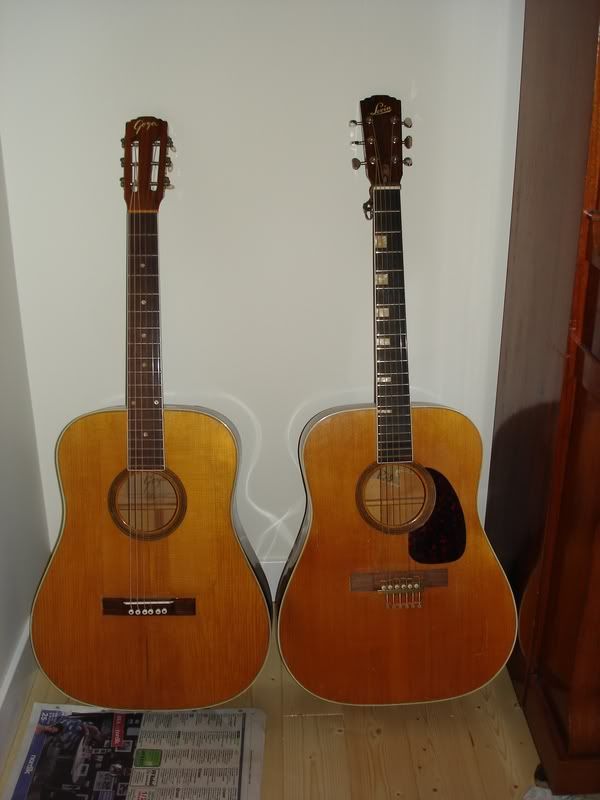I know about the guitar Martin made for Norman Blake with 12 fret neck on a 14 fret body. 000 if I remember correctly. Moves the bridge back into the lower bout a bit.
My question is have any of you tried this on a dreadnought? Or heard one built that way?
I was wondering if it would get too bassy. I have a 000 started 12 fret neck/14 fret body using Honduras rosewood. It got me to thinking (usually causes me trouble) about how this would fly on a dreadnought.
Any thoughts?
My question is have any of you tried this on a dreadnought? Or heard one built that way?
I was wondering if it would get too bassy. I have a 000 started 12 fret neck/14 fret body using Honduras rosewood. It got me to thinking (usually causes me trouble) about how this would fly on a dreadnought.
Any thoughts?
Views: 292
Replies to This Discussion
-
I seem to be missing some thing here or maybe not as I under stand it .If you are building a Intsrument with a 25.4" scale for exaple and it was a 14fret neck the bridge would be 2 frets closer to the hole than if you were building a 12 fret Insturment and the bridge 2 frets further into the bottom bout for a 12 fret . That is the way I build them any way. Like I said maybe I don't under stand were you are coming from ??????????/ I have built the Martin O-45 both with a 12 fret neck and a 14 fret neck useing the same body I can not see anything wrong with ether one of them.Bill.""""""""''
-
For example, on 12 fret dreadnoughts there is more space between the edge of the body and the sound hole than on a 14 fret one. This leaves the bridge pretty much in the same place in the lower bout.
-
I'm not saying this is bad but wouldn't this push the bridge pretty deep into the lower bout? Do you move the X brace lower too or do you make a larger / longer bridge plate to span between the lower legs of the X?
Ned
-
Ned, I'm not sure yet. I've been meaning to call Martin.to see if they would tell me. I heard it had a great bass responce. I am thinking they left the X brace and just used a bigger bridge plate.
Frank might know.
-
Dave when I build a 12 fret I move the x bracing down further from the hole and pull the bottom end of the x bracing angel in a little to shorten up the bridge plate. So in fact you are changing the whole angle of the x bracing. Other wize I leave all the other braces the same.You seem to get a better base respond from the 12 fret this way.Just my experance take it for what it's worth .good luck .Bill.""""""""
-
Thanks Bill, I hadn't thought of it that way. Always open to options.
-
I'm a bit hesitant to bring this up but since you are looking for ideas... Perhaps a bridge doctor type device in conjunction to a longer bridge plate, might allow the X junction to remain closer to the sound hole? Not that I would expect anyone to experiment like this on a commission.
Ned
-
I just went to the martin site and looked at the info on the Norman Blake 000-18.
They say the 12fret/14fret design allows the X brace to be moved toward the sound hole( crossing just below the hole) while moving the bridge lower into the lower bout. 00 size sound hole with 1/4" scalloped bracing.
The whole thing sounds on the light side. Its probably a fantastic sounding guitar. I think I'm gonna have to try one for spec and see. I might use a slightly heavier bridge plate and taper it down as it moves toward the braces.
I think some good stiff adirondack will be in order. Maybe left a little thicker than I normally would.
-
While it's been a long while since I saw Blake perform I actually spent some time with him back stage in the late '70s and he was using a 'heavy medium" set of strings with slightly high action on his Martin ('30s D-18 I think but I really can't remember right now) so the string pull was more than "average" for these days so the endurance of this set up may be more than academic.
Rob
-
This is that way Levin guitars built their 12 fret Goliaths throughout the 60:s.
Here is a Levin LT-18 14 fret next to a Goya F-25 12 fret. The Goya has its X moved 11 mm towards the end block and the bridge has moved with the entire scale approximately 30 mm backwards. I havent compared other differrencies in the bracing. Both guitars are from the mid sixties and they both sound great. The Goya is a bit bassier but they are also differrent materials, the Levin is maple and the Goya is mahogany.

© 2025 Created by Frank Ford.
Powered by
![]()